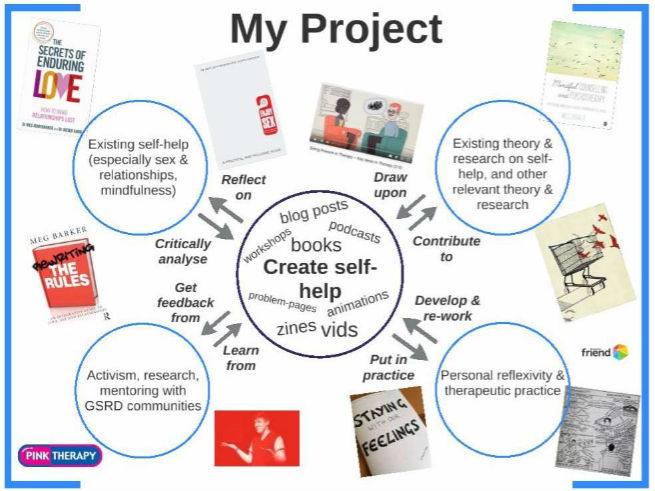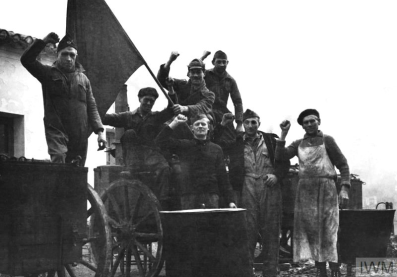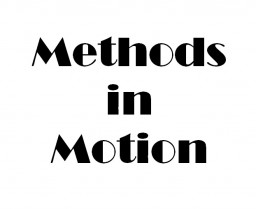My project is quite an unusual one for an academic. It doesn’t involve designing and conducting experiments or interviews, but it does include several different kinds of research. It fairly rarely involves me writing in academic language, but it does draw on academic theory. It doesn’t require much in the way of funding, but it manages to reach a lot of people. In terms of method, I would argue that exploring new formats for conducting and disseminating research can prompt us to ask questions - and allow us to find answers or address groups – that we could not envisage incorporating into traditional formats of investigation.
My project is to produce self-help with a difference. A lot of self-help is produced by people without much knowledge of theory and research; mine is rooted in what we know from academic studies and philosophical ideas, and tries to communicate this in an engaging and accessible way. Most self-help takes a rather individualistic approach to people: ‘this is what is wrong with you and this is how to fix it’; mine takes a more psychosocial perspective: ‘this is what’s wrong with wider cultural assumptions, systems and structures, and here are some ways in which you might navigate them differently’. A lot of self-help promises a one-size-fits-all solution; mine emphasises diversity and the fact that different things work for different people and at different times. I’ve sometimes described it as ‘anti-self-help’ because it doesn’t locate our problems in us as individuals, and its starting point is a gentle criticism of mainstream self-help.
But how is the project of producing self-help a research project, and what methods does it use? Actually my project weaves together various kinds of research and method in order to further the main goal of creating useful self-help materials. You can see this illustrated in the image below.

Starting in the top right of the diagram, perhaps the most obvious way in which my project is a research project is that it draws on academic research and theory: notably the research that’s been done on self-help itself. For example, academics have studied which self-help techniques are helpful to people struggling with different issues, and they’ve also done more critical research about the assumptions and norms that are perpetuated by mainstream self-help. Some of my projects are also attempts to develop methods that get the findings of a particular study - or the ideas in a particular theory - out to the general public in an accessible way. For example, The Secrets of Enduring Love presents the findings of Jacqui Gabb’s OU Enduring Love? Project. Queer: A Graphic History (with artist Julia Scheele) is a comic about what queer theory is and how it might be useful in people’s lives.
Moving anticlockwise to the top left, I’ve also conducted my own research into self-help, which informs my wider project. For example, Ros Gill, Laura Harvey and I are writing an academic book based on our research on sex advice. The method for my part of that was to study 62 sex manuals (I don’t recommend it!) to discover the messages they tend to give people about how to have enjoyable sex. My critical analysis of these books, and other media, informed the sex advice book that I’ve recently written with sex educator, Justin Hancock: Enjoy Sex (How, When and If You Want To).
Down into the bottom left corner, much of my self-help is informed by the research I’ve conducted over the years with members of gender, sexual, and relationship diverse (GSRD) communities. I’ve always felt that the common psychology question of how GSRD can be explained is a problematic one, and that it’s more valuable to ask instead what can be learnt from people who are doing gender, sexuality, or relationships in different ways to the current ‘norm’. As Darren Langdridge, Helen Bowes-Catton, and I have explored in our collaborative work, the methods and theories that allow you to openly reconsider what sexuality and relationships can be are very different to those that start from a closed definition and investigate within those pre-established boundaries. In my book Rewriting the Rules I drew on a lot of this kind of research to give people a sense of all of the different ways in which they could manage their relationships. There’s a feedback loop here too, because I want to keep learning from my GSRD readers. I’m currently starting work on a second edition of Rewriting the Rules and I’ll be conducting survey and focus group discussion research to find out what readers found useful - and less so - to inform how I edit the book.
Finally, moving around to the bottom right, my self-help is also grounded in methods of personal reflection and therapeutic work. My own experience - and that of my clients - is a constant testing ground for what is actually useful in people’s lives. For example, I publish a lot of zines (short self-published magazines) to take people through activities that I, and clients, have found helpful. I’m currently doing some autoethnographic work (that’s where you do in-depth research on your own experience) about what people can learn from tuning into their sexual fantasies. The first glimpse of this work can be found in The Psychology of Sex, which is coming out in 2017. My forthcoming books on gender and on moving beyond binaries with Alex Iantaffi also draw on our own lives and reflections, as well as years of therapeutic work.
Finally, moving back to the centre of the diagram, there’s a kind of research method involved in the creation of the self-help materials themselves: perhaps more akin to the research conducted by people in the humanities, particularly in creative writing. I’m constantly engaged in a dialogue with people about what they’d find most useful, and what formats would be most accessible to diverse audiences, hence my experimentations with different kinds of books, blogs, podcasts, videos, comics, and various other media.
There’s a lot of joy, for me, in the dance between the five related sub-projects depicted here. I enjoy moving between methods, topics and formats - from talking with clients, to collaborating on a zine, to attending a community event, to recording a podcast, to reading a colleague’s latest paper, to writing my personal journal, to analysing some blog posts about a particular issue, to speaking on a panel. I find a deep pleasure in the way that all of these parts of the project weave together and inform each other in a kind of ongoing conversation, and I love that this way of doing things may help to rewrite the rules of what academic work looks like as well!
Find out more:
You might want to check out my Rewriting the Rules blog for more about all of these projects, and keep your eyes peeled for the new megjohnandjustin website which Justin Hancock and I are currently putting together. There’s also more information about my anti-self-help project on its CCIG website.
More on Methods in Motion
The Methods in Motion blogs are by researchers linked to the Centre for Citizenship, Identities and Governance. The blogs represent their opinions emerging from research in progress, and do not necessarily represent the views of the Research Centre or Open University. You can discover more about Methods in Motion on the CCIG website.






Rate and Review
Rate this article
Review this article
Log into OpenLearn to leave reviews and join in the conversation.
Article reviews